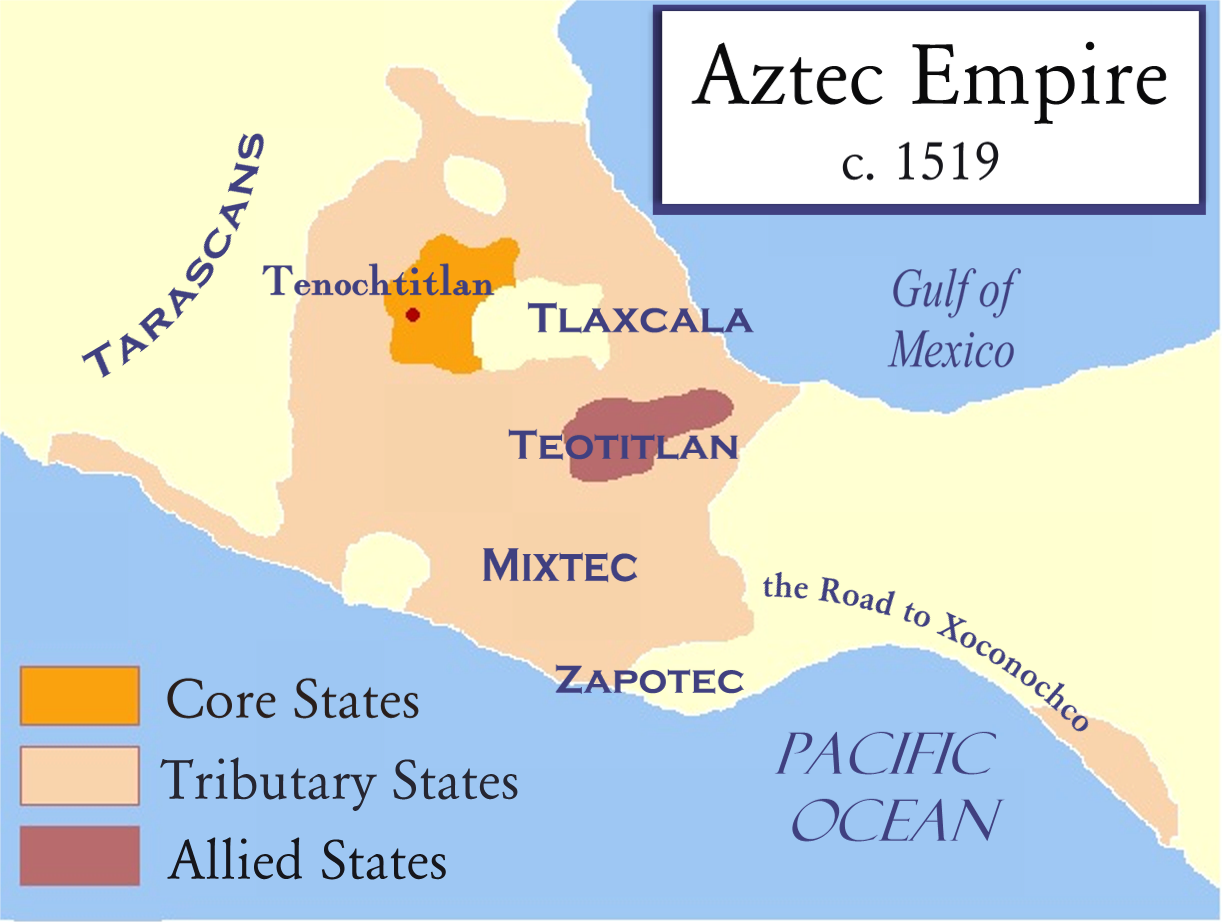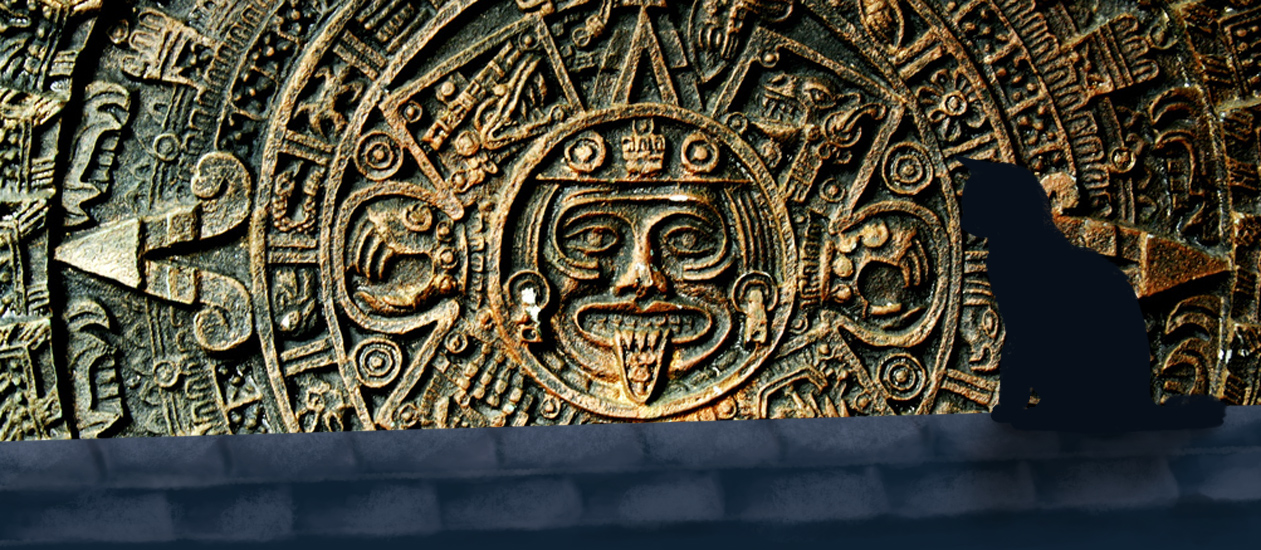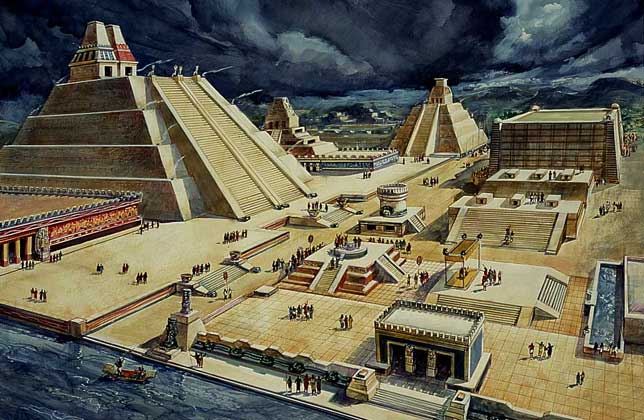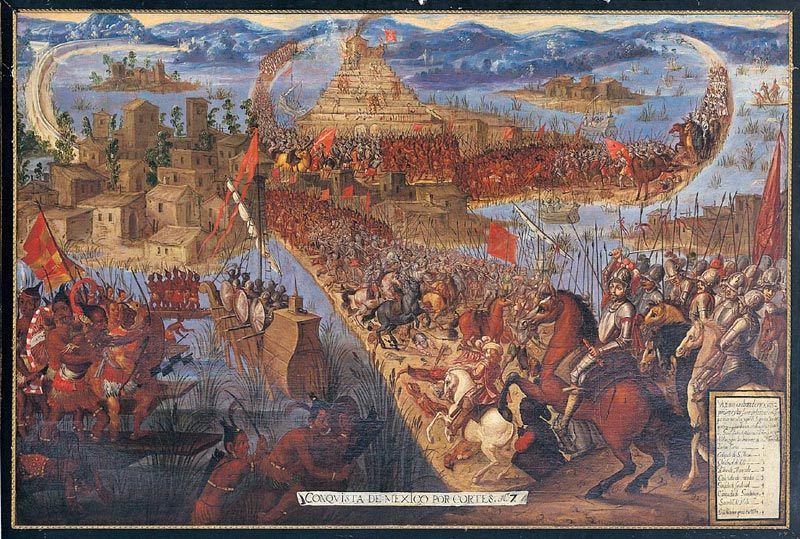United Nahua Republic
"Do you speak French?"
"Only what I learned for diplomatic reasons."
"Like what?"
"I can say 'putain de bâtard'"
"I thought you said you only learned it for diplomacy!?"
"Oh, I used that one all the time."
The United Nahua Republic, commonly called Nahuac, went through a long and bloody history to become one of the leading democracies of the New World.
Structure
The republic is divided into 23 regions, plus the capital region. These regions were based loosely on historical ties, but for the most part were crafted after union to make the huge number of city states incorporated more manageable. The capital region consists of Tlaxcala and the territory ruled by the city before union.
Within each regions are the dozens, sometimes over a hundred, city states that were independent before union. Many of these are ruled by a king, who have about as much power as the mayor of a large city. Kings must still obey the rulings of the republic, but are given significant autonomy.
The only city states that were put in regions they were not historically allies with were Tenochtitlan, Tlacopan, and Texcoco, the members of the former Triple Alliance. These three were separated to discourage the possibility of them uniting and turning against the others once more. Additionally, for 50 years post union, Tenochtitlan was not permitted to have a standing military.
The union has a national military, but it consolidates only in times of war. During peace time, each city state operates their own military just as they did before union. Consolidating the military for an international conflict requires a majority vote in the council.
History
Origins of the Mexica
Our World History
Nahuac began with the Triple Alliance, and the Triple Alliance began with the Mexica.
According to the legendary history of the Mexica, they began as a wandering tribe. A king offered to let them settle on his land in exchange for military service. In the next battle, the Mexica proved themselves to be skilled warriors and the king offered them his daughter as a reward for their great service. The Mexica thanked him for his offering, and decided to use the princess to thank their patron god, Huitzilipochtli, for aiding them in battle. They sacrificed the princess to their god, which infuriated her father when he found out. Outraged, he banished the Mexica from his land.
Huitzilopochtli told his people to wander until they found an omen: an eagle eating a snake, perched on a cactus. In the 13th century, they finally found this omen on a swampy island in Lakes Texcoco. It was there that they would build their city.
Modern Nahua history, which comes from the perspective of the dominant Tlaxcaltec, tells that they built the city on the island not because of divine providence but because the swampy land was the only space available that no one else wanted.
Rise of Tenochtitlan
Whatever the reason, the city they founded was known as Tenochtitlan. Despite the poor location, the Mexica managed to grow strong by utilizing man-made islands to grow food. In time, Tenochtitlan grew into a powerful city-state.


Map of the Triple Alliance by Badseed
In the 15th century, the city-state of Azcapotzalco, which had been the dominant ruler of the Valley of Mexico, attempted to assassinate the ruler of Tenochtitlan out of fear that the Mexica were growing too powerful. In response to this, Tenochtitlan rallied two neighbouring city states - Tlacopan and Texcoco - and launched an attack against Azcapotzalco. They sacked the city and all the power and territory of Azcapotzalco passed to the newly-formed Triple Alliance.
The Triple Alliance was originally designed as an equal collaboration between the three cities, but Tenochtitlan quickly became the dominant member. Throughout the next century, they embarked on expanding their territory and conquering land throughout the Valley of Mexico and beyond. By the 16th century, they demanded tribute from coast to coast.
One of the significant regions they did not conquer was Tlaxcala. This was a city-state very near to Tenochtitlan, and remained free and independant throughout the rise of the Triple Alliance.
For Tlaxcala we are grateful. Every year, the mock Flower Wars we hold with them give our warriors ample time to train, and without an opponent with whom to make pretend war, from where would we gather our captives for sacrifice?
Another year, another attempted invasion from the Mexica. You would think after so many attempts at conquering us, they would just give it up already. How many times must we repel them before they leave us alone?
It is important to note that the Triple Alliance was never a unitary empire. They did not directly rule the territory they took. Local rulers were left in place as long as they provided yearly tribute in the from of gold, feathers, slaves, or other valuables.
Tlaxcala
The city state of Tlaxcala was built near the shores of Lake Texcoco. The Tlaxcala was a republic led by a council of anywhere from 20 to as many as 200 individuals throughout its history. Position on the council was awarded based on merit, primarily military, and so commoners had many chances to achieve glory and find a spot on the council.
Though Tlaxcala was strong, they never achieved the widespread empire that their neighbours created. However, despite being very close to Tenochtitlan and therefor one of the first places invaded, they never came under Mexica rule throughout 100 years of warfare.
Arrival of the French
Diverged History
The Triple Alliance's rule was uncontested until the arrival of a French fleet in 1525. The fleet, led by naval officer Yvon Aveline, landed on the eastern coast of the empire at the city state of Tabasco. Aveline had come with a fleet of about 700 men, but greeted the Tabascans peacefully, and was welcomed into the city as guests. They exchanged gifts as a show of good faith: metal tools, jewellery, and textiles from the French; gold, feathers and a slave from the Tabascans named Malinalli.
Aveline spent several months in Tabasco. During this time, he slowly learned Nahuatl so that he could communicate and learn more about the empire Tabasco explained they were part of. One day, he witnessed baskets of feathers and turquoise being sent away on a road inland. The king of Tabasco explained it was a tribute to the Mexica, who collected wealth from throughout the empire.
Aveline saw this as a great opportunity. If all the wealth in this new land was funneled to the Mexica, that was where he needed to go. He asked them why they gave away their wealth, and they explained the Mexica were too powerful to oppose. Aveline demonstrated his muskets and horses and asked if that was enough power to oppose the Mexica. They agreed, and Aveline began his march to Tenochtitlan with Tabascan warriors at his side.
March to Tenochtitlan
Along the way, they met the many conquered vassal city states that had been oppressed by the Mexica for decades. Aveline negotiated with these groups, who joined him on his march to Tenochtitlan. By the time he reached Tlaxcala, he already had a considerable force behind him.
Negotiations in Tlaxcala were extended. Tlaxcala, ruled by a council and not a single king, needed much more debate and discussion before agreeing to throw their lot in with the French. Cultural hero Tonauac, a high ranking soldier with significant influence with the council, was famous for his hesitancy to trust the foreigners.
I don't trust these pale bastards.
Despite the captain's objections, Tlaxcala came to an agreement with the French in which the French would assist them in overthrowing the Triple Alliance in exchange for favourable trade agreements going forward.
French Deceit
With Tlaxcala's support assured, Aveline left all but a handful of his troops outside the city when he first went in negotiate with the emperor, Moctezuma II. While he was away and the army waited in Tlaxcala, the slave Malinali slipped away and found Tonauac.
She explained that she had no love of the French, and that Aveline had treated her as nothing but a sex slave since she was given to him. She warned him that the French could not be trusted, and that she had overheard them discussing their intentions to replace the Triple Alliance's domination with their own. Tonauac brought her message to the council, and convinced them that they must betray the French before the French did the same to them.
Aveline continued his tradition of peaceful negotiation with Moctezuma. He stayed as a guest in the royal palace and was shown around the city. However, a week into his plans to infiltrated the empire, Tlaxcala moved against him. An assassin from Tlaxcala (popularly said to be Tonauac himself, though there is no evidence for this) infiltrated Tenochtitlan with a gun stolen from the French encampment. In the middle of the city, while Moctezuma and Aveline spoke at the steps of a temple, the Tlaxcaltec shot Moctezuma dead.
The Battle of Tenochtitlan
Full article: Battle of TenochtitlanWith the murder coming from a gun, the Mexica crowd immediately assumed it was French treachery and turned on Aveline. On the outside of the city, the gathered army heard the commotion and Aveline's second-in-command ordered the troops to enter the city and help Aveline. Tlaxcala and the united indigenous army followed.
The Battle of Tenochtitlan lasted five days in all. With the aid of the French horses, artillery, and guns, and the thousands of indigenous soldiers behind them, they ultimately defeated the Mexica.
At the end of the battle, when Aveline and his surviving troops marched out of the city to meet with the leaders of Tlaxcala - and demand what they had been doing starting the fight when they did - the tlaxcalan army turned their bows on them as they walked across the causeway. Taken by surprise and with no cover on the bridge, the French force was massacred. Those that fled the bridge were met by more troops waiting for them at the other end.
Of the 700 soldiers Aveline had brought, 325 of them died in the Battle of Tenochtitlan, and 268 died in the massacre at the bridge. The remaining 107 surrendered to Tlaxcala. Aveline himself died on the bridge.
What About Smallpox?
In our world, the smallpox epidemic was one of the leading causes of the defeat of the Aztecs. During the months-long seige of Tenochtitlan, so many died from smallpox that the Spaniards were easily able to conquer the survivors. European diseases also made an appearance in this timeline, but medical advances from pathstones - especially the medical technology developed by Teyacapan in the 8th century - made these diseases easy to manage and not much of a threat.Union
After the battle, the warriors who had joined from across the empire prepared to return home with the news that Tenochtitlan was no more and they would no longer have to pay annual tribute. Before they left, however, Malinali and Tonauac appeared before the assembled leaders. The idea, it is said, was first suggested by Tonauac, but delivered by Malinali due to him being terribly uncharismatic.
For 100 years, we have lived in thrall to the Mexica. They have taken our gold, our feathers, and even our children. Today, we celebrate the abandonment of our shackles. How long, though, will this freedom last? Before Tenochtitlan, there was Azcapotzalco. After Tenochtitlan, there will be another. What will you do when the armies of Tlacopan march to your doors? Will you fend off the next Tenochtitlan's grasp alone, when it took all of you united to do it today? What will you do if more pale ones arrive? And they will arrive, and they will pick us off one by one if we face them alone. Stand united, maintain this union, and we will be ready to face them when they return.
Her words were persuasive. The soldiers did leave, but this time they sent for their political leaders to return. Kings, village chiefs, and religious leaders from throughout the former Triple Alliance converged in Tlaxcala. Even Cuauhtémoc, the captive leader of the defeated Mexica, was given a place at the table.
The peace talks lasted for nine months. In the end, they wrote a charter agreeing to a peaceful union of their territory, with the Tlaxcaltec republic a political base. Each ruler present inscribed the charter with the pictrograph of their city to agree to its inclusion in the republic. That day marked the beginning of the United Nahua Republic
Founding Date
January 13th, 1527
Type
Geopolitical, Republic
Alternative Names
Nahuac
Demonym
Nahua
Government System
Democracy, Representative
Power Structure
Unitary state
Economic System
Market economy
Currency
Nahua Etl
Legislative Body
The republic is legislates by the council, which consists of 72 representatives from each region, plus the capital territory. Each region is free to choose its representatives however they like. In the beginning, this was generally war heroes, but after decades of stability with few conflicts to create heroes, regions began to shift to oligarchical elections, with representatives voted on by the kings or chiefs of territories based on individuals who rose to prominence as merchants, judges, doctors, or other notable professions.
Although voting is done only by the rulers of a territory, the council is itself is not restricted to nobility. However, nobles make up about 70% of the council, because the wealth and prestige they are born with makes it easier for them to make a name for themselves and thus be considered by the territorial ruler.
Location
Human Sacrifice
Human sacrifice was practiced by most cultures within the republic before contact with the Europeans, and continued to be practiced after union as well. It was considered an unfortunate necessity to ensure the sun didn't die and the rain continued to arrive.
Sensibilities gradually changed throughout the late 16th and 17th centuries as they had increasing contact with foreign states. The reality that these other states never sacrificed anyone and yet still received annual rain caused great debate among Nahuas. Some argued that the international communities were simply benefiting from the sacrifices performed in Nahuac, while others argued that sacrifice was a relic from a simpler time.
In the 18th century, Nahuac was affected by the Age of Enlightenment as much as anywhere else. Nahua scholars travelled to Europe to study, and Europeans in Nahuac learned from the advanced astronomers there. The age of science and reason made sacrifice seem more unnecessary than ever, until majority opinion finally shifted to be anti-sacrifice.
Human sacrifice was made illegal in all regions in 1741. Many communities still perform their traditional ceremonies but substitute animals instead. A major problem for law enforcement is catching the killers who are so certain that the sun will die without sacrifice that they perform illegal sacrifices in their homes to "save the world".




